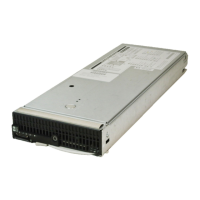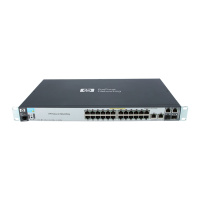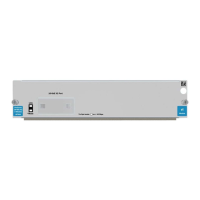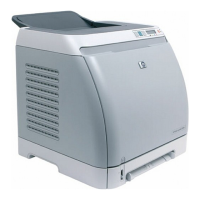Do you have a question about the HP ProLiant Lights Out-100 and is the answer not in the manual?
Explains standard and optional operational features of HP Onboard Administrator Powered by Lights-Out 100 (LO100).
Details new features added in this release of LO100, including support for specific HP ProLiant server models.
Describes LO100's role in delivering remote control of vital server resources, supporting IPMI 2.0 and DCMI 1.0.
Lists the tasks that can be performed with LO100, such as remote graphic console access and power control.
Details the standard features included with LO100 for various HP ProLiant server models.
Explains optional features activated by purchasing the Lights-Out 100i Advanced Pack.
Introduces the SmartStart Scripting Toolkit and the LO100CFG utility for automated server deployment.
Guides on setting up network connectivity for remote management through Ethernet or serial ports.
Describes the four account types supported by LO100 and their default credentials.
Explains how to access the BIOS Setup Utility and provides ESC key equivalents for function keys.
Details how the server serial port serves as an interface to LO100 and its configuration.
Provides step-by-step instructions for configuring the serial port settings via the BIOS Setup Utility.
Explains how to configure LO100 LAN port access using dedicated or shared Ethernet ports.
Guides on how to view or obtain a DHCP IP address using the BIOS Setup Utility.
Describes how the DNS naming feature allows referencing servers by name instead of IP address.
Provides instructions to disable DHCP and configure a static IP address through the BIOS Setup Utility.
Details how to enable or disable Telnet and HTTP services via the BIOS Setup Utility for different server models.
Lists TCP and UDP port numbers for LO100 network-accessible features for security configuration.
Explains how to update LO100 firmware using the ROMPaq utility and where to find downloads.
Provides instructions for remotely updating firmware using the `load` command via TFTP.
Guides on installing new firmware images via the LO100 web interface and TFTP server.
Details how to update BMC firmware using the Lights-Out 100 Online Flash Utility for supported OS.
Explains how SSL provides security for remote management by encrypting data over unsecured networks.
Describes SSH as a secure protocol for remote login, authentication, and data integrity.
Guides on connecting to a server using an SSH utility and accepting the server's public key.
Details PuTTY as a terminal emulation product supporting telnet and SSH, with usage instructions.
Explains OpenSSH as a free SSH protocol client available for Linux.
Introduces the Command Line Protocol (CLP) for server management, replacing the simple CLI.
Details the basic CLP commands like help, cd, load, reset, set, show, start, stop, exit, and version.
Refers to sections describing functionality matching CLP commands and web interface features.
Explains LO100's support for Data Center Manageability Interface (DCMI).
Details LO100's support for the industry-standard IPMI 2.0 and its additional features.
Covers logging into the remote management processor via web browser or CLP.
Describes the basic remote management capabilities accessible through the LO100 web browser.
Explains how LO100 enables remote operation of server power functions via web browser or CLP.
Details how to control server power (on/off/cycle) and identify the server using the Virtual Power screen.
Provides CLP commands to power on, power off, and reset the server.
Explains LO100's capability for OS-independent remote monitoring of server sensors.
Guides on accessing and viewing sensor data (temperature, fans, voltage) via the web browser.
Provides steps to view sensor data through the BIOS Setup Utility.
Details how to configure LO100 to take actions on event messages using CLP commands.
Explains how to configure IPMI PEF to set alarms or conditions to alert a management console.
Describes how LO100 captures and stores the IPMI event log for access via browser, CLP, or BIOS.
Guides on accessing the System Event Log screen via the web browser.
Provides steps to access the system event log using the Command Line Protocol (CLP).
Details how to access the system event log via the BIOS Setup Utility.
Explains the Virtual KVM feature for remote graphic console access, requiring an Advanced Pack license.
Details the Remote KVM/Media Viewer, its menus (Control, Preferences, Help) and options.
Guides on changing mouse, keyboard, and logging settings within the remote graphic console.
Explains how to synchronize local and server mouse pointers by adjusting pointer options.
Describes the eight system buttons available on the virtual keyboard for remote console interaction.
Details how LO100 Virtual Media enables adding, browsing, removing, and sharing media devices.
Provides steps to add a new virtual media device, specifying type and file name.
Guides on sharing a virtual media device from the Storage Devices window.
Explains how to access the remote console via BIOS console text-redirection or Windows Server 2003 console.
Details how to view boot process remotely and manage BIOS via Telnet console redirection.
Guides on enabling remote login on ttySO for Linux by modifying BIOS Setup Utility and boot documents.
Explains how to enable and use Windows EMS management for basic tasks and process control.
Describes the Hardware Inventory page for identifying processor presence on a target server.
Explains how to edit user names and passwords and manage user accounts.
Guides on modifying user settings and enabling/disabling accounts via the web interface.
Guides on changing user names, passwords, and group settings using the Command Line Protocol.
Covers viewing and modifying network settings (IP, subnet, DHCP) via web browser, CLP, or BIOS.
Details how to configure network parameters like IP address, subnet mask, and DHCP via the web interface.
Provides steps to configure static or DHCP IP addresses through the BIOS Setup Utility.
Guides on configuring network settings like IP address, subnet mask, and DHCP using CLP commands.
Explains how to activate LO100 firmware by applying a license key through the browser.
Details the process of creating and installing a user-specific private key or certificate for SSH and SSL.
Provides steps to create a 1,024-bit DSA key and certificate using Win32 OpenSSL.
Guides on installing certificates and private keys for SSL/SSH connections via the web browser.
Details installing certificates and private keys for SSL/SSH connections using CLP commands.
Explains how HP Systems Insight Manager discovers and manages LO100.
Provides solutions for character and line feed issues when using Telnet or PuTTY clients.
Explains VLAN tagging for isolating management traffic and its server support.
Details server support for VLAN tagging, specifying compatible ProLiant series and management ports.
Provides host-based configuration commands for setting VLAN IDs using IPMI.
Information on HP LO 100i Advanced Packs, Technical Support, and Update licenses.
Provides contact details for HP authorized resellers and technical support worldwide.
Lists essential information to have ready before contacting HP support.
Explains standard and optional operational features of HP Onboard Administrator Powered by Lights-Out 100 (LO100).
Details new features added in this release of LO100, including support for specific HP ProLiant server models.
Describes LO100's role in delivering remote control of vital server resources, supporting IPMI 2.0 and DCMI 1.0.
Lists the tasks that can be performed with LO100, such as remote graphic console access and power control.
Details the standard features included with LO100 for various HP ProLiant server models.
Explains optional features activated by purchasing the Lights-Out 100i Advanced Pack.
Introduces the SmartStart Scripting Toolkit and the LO100CFG utility for automated server deployment.
Guides on setting up network connectivity for remote management through Ethernet or serial ports.
Describes the four account types supported by LO100 and their default credentials.
Explains how to access the BIOS Setup Utility and provides ESC key equivalents for function keys.
Details how the server serial port serves as an interface to LO100 and its configuration.
Provides step-by-step instructions for configuring the serial port settings via the BIOS Setup Utility.
Explains how to configure LO100 LAN port access using dedicated or shared Ethernet ports.
Guides on how to view or obtain a DHCP IP address using the BIOS Setup Utility.
Describes how the DNS naming feature allows referencing servers by name instead of IP address.
Provides instructions to disable DHCP and configure a static IP address through the BIOS Setup Utility.
Details how to enable or disable Telnet and HTTP services via the BIOS Setup Utility for different server models.
Lists TCP and UDP port numbers for LO100 network-accessible features for security configuration.
Explains how to update LO100 firmware using the ROMPaq utility and where to find downloads.
Provides instructions for remotely updating firmware using the `load` command via TFTP.
Guides on installing new firmware images via the LO100 web interface and TFTP server.
Details how to update BMC firmware using the Lights-Out 100 Online Flash Utility for supported OS.
Explains how SSL provides security for remote management by encrypting data over unsecured networks.
Describes SSH as a secure protocol for remote login, authentication, and data integrity.
Guides on connecting to a server using an SSH utility and accepting the server's public key.
Details PuTTY as a terminal emulation product supporting telnet and SSH, with usage instructions.
Explains OpenSSH as a free SSH protocol client available for Linux.
Introduces the Command Line Protocol (CLP) for server management, replacing the simple CLI.
Details the basic CLP commands like help, cd, load, reset, set, show, start, stop, exit, and version.
Refers to sections describing functionality matching CLP commands and web interface features.
Explains LO100's support for Data Center Manageability Interface (DCMI).
Details LO100's support for the industry-standard IPMI 2.0 and its additional features.
Covers logging into the remote management processor via web browser or CLP.
Describes the basic remote management capabilities accessible through the LO100 web browser.
Explains how LO100 enables remote operation of server power functions via web browser or CLP.
Details how to control server power (on/off/cycle) and identify the server using the Virtual Power screen.
Provides CLP commands to power on, power off, and reset the server.
Explains LO100's capability for OS-independent remote monitoring of server sensors.
Guides on accessing and viewing sensor data (temperature, fans, voltage) via the web browser.
Provides steps to view sensor data through the BIOS Setup Utility.
Details how to configure LO100 to take actions on event messages using CLP commands.
Explains how to configure IPMI PEF to set alarms or conditions to alert a management console.
Describes how LO100 captures and stores the IPMI event log for access via browser, CLP, or BIOS.
Guides on accessing the System Event Log screen via the web browser.
Provides steps to access the system event log using the Command Line Protocol (CLP).
Details how to access the system event log via the BIOS Setup Utility.
Explains the Virtual KVM feature for remote graphic console access, requiring an Advanced Pack license.
Details the Remote KVM/Media Viewer, its menus (Control, Preferences, Help) and options.
Guides on changing mouse, keyboard, and logging settings within the remote graphic console.
Explains how to synchronize local and server mouse pointers by adjusting pointer options.
Describes the eight system buttons available on the virtual keyboard for remote console interaction.
Details how LO100 Virtual Media enables adding, browsing, removing, and sharing media devices.
Provides steps to add a new virtual media device, specifying type and file name.
Guides on sharing a virtual media device from the Storage Devices window.
Explains how to access the remote console via BIOS console text-redirection or Windows Server 2003 console.
Details how to view boot process remotely and manage BIOS via Telnet console redirection.
Guides on enabling remote login on ttySO for Linux by modifying BIOS Setup Utility and boot documents.
Explains how to enable and use Windows EMS management for basic tasks and process control.
Describes the Hardware Inventory page for identifying processor presence on a target server.
Explains how to edit user names and passwords and manage user accounts.
Guides on modifying user settings and enabling/disabling accounts via the web interface.
Guides on changing user names, passwords, and group settings using the Command Line Protocol.
Covers viewing and modifying network settings (IP, subnet, DHCP) via web browser, CLP, or BIOS.
Details how to configure network parameters like IP address, subnet mask, and DHCP via the web interface.
Provides steps to configure static or DHCP IP addresses through the BIOS Setup Utility.
Guides on configuring network settings like IP address, subnet mask, and DHCP using CLP commands.
Explains how to activate LO100 firmware by applying a license key through the browser.
Details the process of creating and installing a user-specific private key or certificate for SSH and SSL.
Provides steps to create a 1,024-bit DSA key and certificate using Win32 OpenSSL.
Guides on installing certificates and private keys for SSL/SSH connections via the web browser.
Details installing certificates and private keys for SSL/SSH connections using CLP commands.
Explains how HP Systems Insight Manager discovers and manages LO100.
Provides solutions for character and line feed issues when using Telnet or PuTTY clients.
Explains VLAN tagging for isolating management traffic and its server support.
Details server support for VLAN tagging, specifying compatible ProLiant series and management ports.
Provides host-based configuration commands for setting VLAN IDs using IPMI.
Information on HP LO 100i Advanced Packs, Technical Support, and Update licenses.
Provides contact details for HP authorized resellers and technical support worldwide.
Lists essential information to have ready before contacting HP support.












